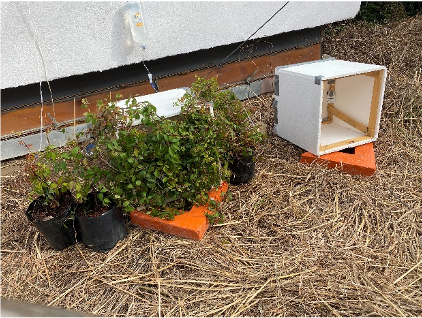Thermal monitoring of vertical barrier with vegetation, evaluating performance through experimentation and simulation tool
DOI:
https://doi.org/10.37636/recit.v5n1e94Keywords:
Vertical barriers, Vegetation, SimulationAbstract
As a result of global warming and the environmental deterioration of which we are victims, architectural innovation through sustainable design is considered necessary, and the positive thermal effects of vegetation in its integration are considered necessary. The purpose of this work was to investigate the use of vegetation as a vertical barrier as a bioclimatic strategy and to evaluate its performance in an experimental module; The methodology used was carrying out an experimental monitoring and using the thermal simulation tool, in both cases, to verify the contribution to the improvement of the environmental quality with the decrease of the interior temperature. The results allowed to demonstrate the reduction of the indoor air temperature, concluding that with the result obtained an ecological alternative is sought, promoting the renewal and purification of the air as a project strategy. Taking into account that each action can have environmental consequences and in favor of reducing energy consumption, due to artificial air conditioning. The research is supported by the benefit of the tools used for thermal simulation, as instruments for urban planning and sustainable architecture, since through these it is possible to evaluate the different design alternatives, predicting the thermal behavior of areas already built or not, without the need for extensive field work.
Downloads
References
R. Sola Nadal, “Acciones locales frente a los retos del cambio climático en España: Objetivos globales, soluciones locales”, Publicacions Universitat Rovira I Virgili, 2019. https://doi.org/10.17345/9788484247821 DOI: https://doi.org/10.17345/9788484247821
L. A. Vargas Robles “Percepción del ambiente térmico en espacios de transición de clima cálido seco”, Tesis doctoral, Universidad de Colima, Facultad de arquitectura y diseño, 2016.
L. Peña Barrera, “Diseño Bioclimático”, Primera edición, Ciudad Juárez, Chihuahua, México: Universidad Autónoma de Ciudad Juárez, 2015.
S. Hernández, “La sustentabilidad en la enseñanza de la arquitectura en México,” México, Revista La Colmena, [S.l.], n. 59, p. 107-113, oct. 2017. ISSN 2448-6302. Disponible en: <https://lacolmena.uaemex.mx/article/view/5989.
M. E. Sosa y G. Siem, “Manual de diseño para edificaciones energéticamente eficientes en el trópico,” Ediciones FAU UCV, Caracas, Venezuela, 2012.
E. T. Haro Carbajal, “Comportamiento de dos tipos de cubiertas vegetales, como dispositivos de climatización, para climas cálidos sub-húmedos,” Tesis de maestría, Universidad de Colima, Facultad de arquitectura y diseño, 2009.
E. F. Villegas Gutiérrez, “Estudio experimental con dispositivos de sobrecubierta como estrategia de control solar para un clima cálido sub-húmedo,” Colima, Universidad de Colima, 2015.
L. Fajardo, “Desempeño costo – beneficio de dos sistemas pasivos de climatización en cubiertas para climas cálidos – sub húmedo,” Caso Coquimatlán, Colima. Tesis para obtener el grado de Maestro en Arquitectura. Colima, México, 2005.
A. Beltrán-Melgarejo, M. Vargas-Mendoza, A. Pérez-Vázquez y J. García-Albarado, “Confort térmico de techos verdes con Cissus verticillata (Vitaceae) en vivendas rurales tropicales,” Revista mexicana de ciencias agrícolas, 5(spe9), 1551-1560. https://dx.doi.org/10.29312/remexca.v0i9.1047, 2014. DOI: https://doi.org/10.29312/remexca.v0i9.1047
J. Cárdenas, G. Osma y G. Ordóñez “Herramienta metodológica para la evaluación energética mediante simulación de edificaciones en el trópico,” Rev. UIS Ing., vol. 18, no. 2, pp. 259-268, 2019. doi: https://doi.org/10.18273/revuin.v18n2-2019024. DOI: https://doi.org/10.18273/revuin.v18n2-2019024
E. Orlando y L. Berkeley, “EnergyPlus Testing with ANSI/ASHRAE Standard 140-2001 (BESTEST),” Environ. Res., vol. 2001, no. May, 2003.
J. M. Casas Arredondo, “Simulación térmica de edificaciones con Energy Plus y Ener-Hábitat: Análisis de la interacción entre los componentes de la envolvente,” Tesis para optar por el grado de Maestría en Ingeniería, Universidad Nacional Autónoma de México, Temixco, Morelos, 2014.
A. Flores Condori, “Simulación del desempeño térmico en viviendas altoandinas sostenibles con climatización pasiva en la provincia de El Collao,” Tesis, Universidad Nacional del Altiplano, Escuela de Posgrado, Puno, Perú, 2018.
V. A. Fuentes Freixanet, “Mapas bioclimáticos de la República Mexicana,” Universidad Autónoma Metropolitana. Unidad Azcapotzalco. División de Ciencias y Artes para el Diseño. México D.F., 2014.
E.M. González Cruz, “Selección de materiales en la concepción arquitectónica bioclimática”, Instituto de Investigaciones de la Facultad de Arquitectura y Diseño (IFAD)
Universidad del Zulia 4011-A-526 Maracaibo, Venezuela.
(CONAVI) Comisión Nacional de Vivienda. “Código de Edificación de Vivienda”, 3ra. Edición, 2017.

Published
How to Cite
Issue
Section
Categories
License
Copyright (c) 2022 Carmiña Elizabeth Dominguez Cicorio, Luis Aaron García Solorzano, Raúl Pavel Ruíz Torres

This work is licensed under a Creative Commons Attribution 4.0 International License.
The authors who publish in this journal accept the following conditions:
The authors retain the copyright and assign to the journal the right of the first publication, with the work registered with the Creative Commons Attribution license 4.0, which allows third parties to use what is published as long as they mention the authorship of the work and the first publication in this magazine.
Authors may make other independent and additional contractual agreements for the non-exclusive distribution of the version of the article published in this journal (eg, include it in an institutional repository or publish it in a book) as long as they clearly indicate that the work it was first published in this magazine.
Authors are allowed and encouraged to share their work online (for example: in institutional repositories or personal web pages) before and during the manuscript submission process, as it can lead to productive exchanges, greater and more quick citation of published work (see The Effect of Open Access).











